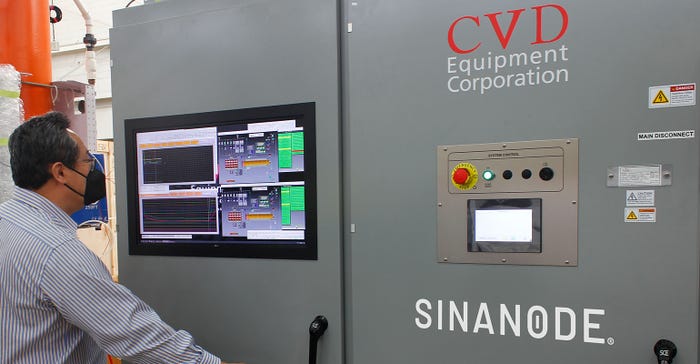Inside OneD’s Silicon Anode Solution for EV Batteries
OneD’s chief technology officer walks us through the promise and problems with EV batteries, and how nanowires made of plentiful silicon offer a stable solution.
August 30, 2023

Dr. Yimin Zhu, chief technology officer for OneD Battery Sciences of Palo Alto, CA.Credit: OneD Battery Sciences
Longer range, faster charging, and affordable, scalable production—these are the holy grails of electric vehicle (EV) battery technology.
OneD Battery Sciences of Palo Alto, CA, offers its silicon anode technology SINANODE as a “winning solution” to those challenges. Silicon anodes can store much more charge in LI batteries than graphite can—but silicon anodes can also undergo significant volumetric fluctuations when charging and discharging. In his wide-ranging conversation with Battery Technology, Dr. Yimin Zhu, chief technology officer for OneD, described SINANODE's three unique capabilities to overcome those fluctuations:
Silicon (Si) nanowires are expanded and contracted in the graphite particle’s pores where Si nanowires are grown, and in the electrode pores between the graphite particles, which provide an electrically and mechanically stable anode layer.
Si nanowires have low surface area/volume ratio, which intrinsically mitigates its pulverization during charging and discharging cycles. This also reduces the swelling of the silicon-graphite anode layer.
The formulated commercial electrolyte provides a stable solid electrolyte interface (SEI) and good ionic conductivity. This avoids excessive reactivity between the silicon surfaces and the electrolyte.
“If you consider the average cathode electrode capacity of 200mAh/g in the cells, just increasing the specific capacity of the silicon-based anode can increase the cell energy density by about 20% to 35% in comparison to graphite anode-based cells,” Zhu said. “Furthermore, not only can our SINANODE technology be leveraged at scale and low cost, but it can also be adjusted/customized based on the graphite materials and to the specific capacities of the car manufacturer.”
Additionally, “the SINANODE process produces silicon with less energy consumption and a much lower carbon footprint than graphite. It reduces the graphite needed in EV batteries and enhances the supply of graphite produced in North America or Europe with a fraction of the carbon footprint compared to the graphite currently imported from Asia.”
General Motors is on board with exploring SINANODE technology: Last year, GM announced a partnership with OneD to conduct joint R&D on silicon anode battery technology.
Overcoming EV battery hurdles
The core requirement for reliable electric transportation is simple, Zhu asserted: Manufacture cells with high energy density to enable longer range. This requires the use of high specific-capacity materials such as silicon composite anode material and Ni-rich cathode material.
“If we focus on anode materials, silicon stands out among all anode materials because its theoretical capacity is relatively high, reaching 3579mAh/g at ambient conditions,” Zhu explained. “This is about 10 times that of graphite.”
Silicon is one of the most attractive anode materials because it effectively increases the energy density of batteries due to its low lithium insertion potential, Zhu noted. In addition, silicon is an abundant natural element, is available at a low price, and is environmentally friendly.
“When considering a representative cathode electrode capacity of 200mAh/g in the cells, just increasing the specific capacity of silicon-based anode can increase the cell energy density by about 20% to 35% in comparison with graphite-based cells,” he said.
As the industry addresses how to increase energy density, “we cannot ignore the importance of fast ionic and electronic transport,” he continued. “This electron and ion movement through and between the active materials, binders, and conductive carbon particles in the electrodes is critical because a battery’s high energy density and high-rate capabilities fundamentally need fast-charge transport through thick electrodes. The charge transport strongly relies on the microstructure and porosity of the compressed composite in the electrodes. Silicon nanowires are such a high-capacity material that they enable fast ionic and electronic transport throughout the electrode.”
Charging speed is another pressing concern.
“Fast charging requires the use of thermodynamically advanced active materials, such as Si composite, with an anode potential higher than that of metallic lithium plating. Battery manufacturers also need materials with a kinetically favorable shape, such as silicon nanowires, that have a lithium-ion diffusion coefficient four times faster than that of graphite.
“OneD’s SINANODE technology platform grows Si nanowires on graphite particles, or inside pores of the graphite particles. This takes advantage of well-established graphite electrode engineering design, while leveraging silicon to enhance the graphite for fast charging and longer range.”
Of course, the bottom line, as ever, is material cost.
“OEMs and cell makers must produce materials at scale and at low cost—which is difficult, as EV batteries currently account for anywhere from 30% to 40% of the total EV cost,” Zhu said. “We designed the SINANODE platform based on the existing graphite supply chain and the well-established silane supply used in the solar cell industry.
“Furthermore, OneD’s reactor design works with existing, commercially available equipment: chemical vapor deposition technology. By working within established processes and improving the capacity of graphite, SINANODE can be effectively scaled within existing production structures to help produce more affordable, long-range EV batteries.”
In our wide-ranging interview, Dr. Zhu—who holds more than 80 patents/applications worldwide in his more than two decades of industrial and academic experience—offered insights into two other emerging segments of EV battery technology:
The challenges of solid-state batteries
While LI batteries dominate the market, industry experts envision a solid-state alternative that could double vehicle range. But materials are a challenge, Zhu cautioned.
“Solid state electrolyte (SSE) is the key to solid state batteries (SSB),” he said, but “there is not enough data to prove SSE materials can be synthesized or produced in large quantities without issues—especially the ability to produce SSE materials that are uniform and offer high conductivity. There is a well-known learning curve when it comes to solid state, and any materials used would have to help solve issues around scaling up.
“In looking at how to use the material to make electrodes and electrode assemblies, the critical and challenging interfaces between layers or particles within layers (i.e., active material particle to particle, SSE particle to active material particle, etc.) have not been fully understood and cannot be well controlled.”
EV batteries need high-speed electrode coating and cell assembling, he added. “The conventional electrode coating and cell fabrication must still be significantly improved to realize fast charging and high energy density, even using a liquid electrolyte and conventional separator. To achieve good conductivity, SSEs need to be mixed into the electrodes.
At the same time, the SSE’s thin film may act as a separator to avoid Li dendrite formation, he noted. The SSE’s thin film thickness may also need to be less than 30 µm to achieve the desired ionic conductivity.
“If SSE material production still has issues, it is hard to believe a defect-free SSE thin film separator or SSE-involved electrodes can be produced at a high enough speed to enable large-volume production without issues or challenges. The interfacial resistance and defects may have a very negative impact on the electrode and quality, and the safety of the SSB may not be as good as one expects if the SSB requires high compression to improve its conductivity,” he warned:
“It may take another decade or more to have cost-competitive SSBs that offer better safety, high energy density, wider temperature range and longer cycle life. The cost factor is essential when it comes to EV OEMs determining whether to adopt SSBs for their EVs or for consumers to determine if it is affordable to buy such SSB-EVs.”
Progress with hydrogen-powered FCEVs
FCEVs—fuel-cell electric vehicles—powered by hydrogen have advanced in viability, as hydrogen fuel cells have made good progress in market scale, technology and application demonstration, Zhu said.
“We are looking forward to more progress in the hydrogen energy industry, especially reductions in its cost and in precious metal catalyst usage, as well as establishing more hydrogen filling stations.” The following important challenges remain, he noted:
• The service life of fuel cells is relatively short—about half that of a car engine. Operating under high temperatures and pressures accelerates the degradation of reactor components. In addition, frequent start-stop and transient changes in peak power can also affect the life of the fuel cell.
• The catalyst in the fuel cell stack is easily contaminated, resulting in performance degradation or failure. Common contaminants include sulfides, carbon oxides, metal ions, etc.
• The reliability of fuel cells in extreme climates and harsh road conditions still has challenges, such as high temperature, low temperature, and humid environments.
While fuel cell commercial vehicles have progressed thanks to fewer restrictions in size and volume, “there’s still the need for longer range and increased power. Successful FCEV commercialization must rely on passenger cars, for which we need to carefully consider fuel cell system prices. For example, a fuel cell system has a price of $140/kilowatt for an 80-kilowatt FCEV. As such, the fuel cell system may have a cost of $11,200 in comparison to the current battery pack of $7,500. For pure electric vehicles, this is still more expensive.
“Based on the current technological advancement and scale expansion, it may take another decade for the cost reduction and the hydrogen filling station infrastructure to be established. These may require collaboration between industry and government, not just locally but worldwide.”
Click through to learn more about OneD and its research and production methods.
About the Author(s)
You May Also Like





